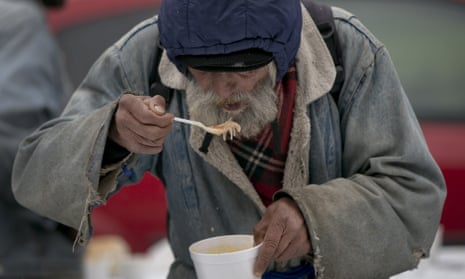How is it that homelessness – one of the most egregious violations of human rights globally – can be so invisible?
The answer lies in the fact that we have done pretty much everything we can to erase homeless people from our sight and from our minds.
How governments, the media, and the affluent treat homeless people has a significant impact on how the rest of us view them and, ultimately, how homeless people view themselves. They have become a social group that, if not ignored completely, is faced with relentless vilification, discrimination, criminalisation and even hate crimes.
In many countries, homeless people who are engaged in the simple acts of eating and sleeping in the only spaces available to them – parks, public squares, or vacant lands – are subject to criminal sanction, given tickets (like illegally parked cars), and forcibly removed from city centres (also like illegally parked cars). Left to languish like garbage in a landfill on the periphery of society, they are rendered completely invisible. While this may be the preferred approach for some governments, it only cements stigmatisation and helps internalise discrimination against those who are homeless.
Around the world, homeless people are referred to in derogatory terms – vermin, cockroaches, pigeons – things to be exterminated. They are seen as dirty, lacking morals, and burdens on society. And people who are homeless are subject to horrific acts of violence based in hate: youth gangs are known to target and beat street homeless, and women who are homeless experience alarming rates of sexual violence, including rape. Instead of immediately responding to address the harm, as governments might be expected to do, the victims become statistics at best.
All of this – and it’s just the tip of the iceberg – makes it possible for us to walk by homeless people’s makeshift abodes without a glance, to ignore the fact that many people are struggling to survive without electricity, heat in the winter, running water, a toilet or even a clean place to sleep. This paves the way for those of us with privilege to literally step over homeless people in the street and see and feel nothing. No connection, no kinship, no responsibility, no compassion. Filled with discriminatory misperceptions of who is homeless and why, it’s easy for us to assume homeless people are responsible for their own demise.
But we need to resist the urge to blame the victim. You see, if there were just several hundred homeless people worldwide we might reasonably conclude that homelessness is about the bad choices or bad luck of a few. But the millions of people worldwide sleeping rough, doubled up with family and friends in overcrowded housing, living with violent partners or in squalor with no legal rights to their homes, suggests that there is more at play than individual pathologies. It suggests that governments are taking decisions, and creating societies that produce homelessness, that their policies and programmes are failing vulnerable and marginalised groups.
It’s also testament to the fact that governments and the private sector are in step with each other, promoting the view that housing is a commodity: something for rich people to invest in, trade and solidify their privilege, rather than a human right to which poor and low-income people are entitled.
The simple truth is that homelessness is the failure of states to implement the right to housing. And they do so with impunity.
But the tyranny of the haves over the have-nots could very well be over in the next 15 years if governments make good on the implementation of the sustainable development goals. When the goals were adopted on 25 September, governments around the world, perhaps unwittingly, agreed to end homelessness by 2030 and committed to “ensure access for all to adequate, safe and affordable housing and basic services”.
So there is global agreement that it is time to make the invisible visible. This will require governments to invite homeless people back into their conception of the human family, to recognise their inherent dignity and their equal and inalienable rights.
It means, for example, adopting strategies to end homelessness with measureable benchmarks and timelines; immediately addressing discrimination against people based on their housing status; recognising that the right to life, and all other human rights, also extend to those who are homeless; and providing homeless people with opportunities to help develop strategies and programmes to address their own conditions. This is a human rights approach.
In October 2016 the UN world conference on housing and sustainable urban development, Habitat III, will be an opportunity for states to implement this approach, flex their political will and enact a vision of cities as places that restore dignity, ensure equality and return the streets to their rightful purpose.
Leilani Farha is the UN special rapporteur on the right to housing
Sign up for your free Guardian Housing network newsletter with news and analysis sent direct to you every Friday. Follow us: @GuardianHousing

